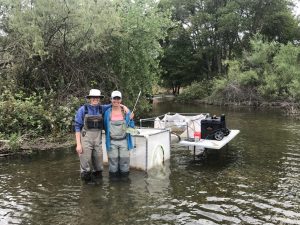 There are many benefits of being part of a large, diverse lab. One of the most fun (and I think most valuable) of these is the opportunity to help other grad students with their fieldwork. A few weeks ago, I spent the day on the Mokelumne River with Megan Sabal, a Ph.D student in the Palkovacs and RC Labs.
There are many benefits of being part of a large, diverse lab. One of the most fun (and I think most valuable) of these is the opportunity to help other grad students with their fieldwork. A few weeks ago, I spent the day on the Mokelumne River with Megan Sabal, a Ph.D student in the Palkovacs and RC Labs.
Aside from getting to watch juvenile salmon swim through a staged “migration route” with and without predator cues (the scent and sights of predators), I got a window into the thought process of another scientist. Because I study social-ecological systems and ecosystem food webs, I think that I sometimes overlook dynamics that occur at the level of the individual organism. Megan, on the other hand, is always thinking about how individual differences in behavior or physiology of any given fish might impact the wider environment or the population that it is a part of. In the experiment that Megan just completed, she’s hypothesizing that differences in individual salmon’s behavioral response to predators impact their migration rates, potentially their feeding ecology, and ultimately their survival and whether or not they recruit into the fishery as adults.
In the context of the group of rockfish that call the kelp forest ecosystem home (my study system), individual differences in rockfish feeding ecology almost certainly exist. And though my approach will remain one that brushes over this individual variability to characterize the community or population, a day on the Mokelumne was a good reminder to take time now and again to focus in on the individual fish.